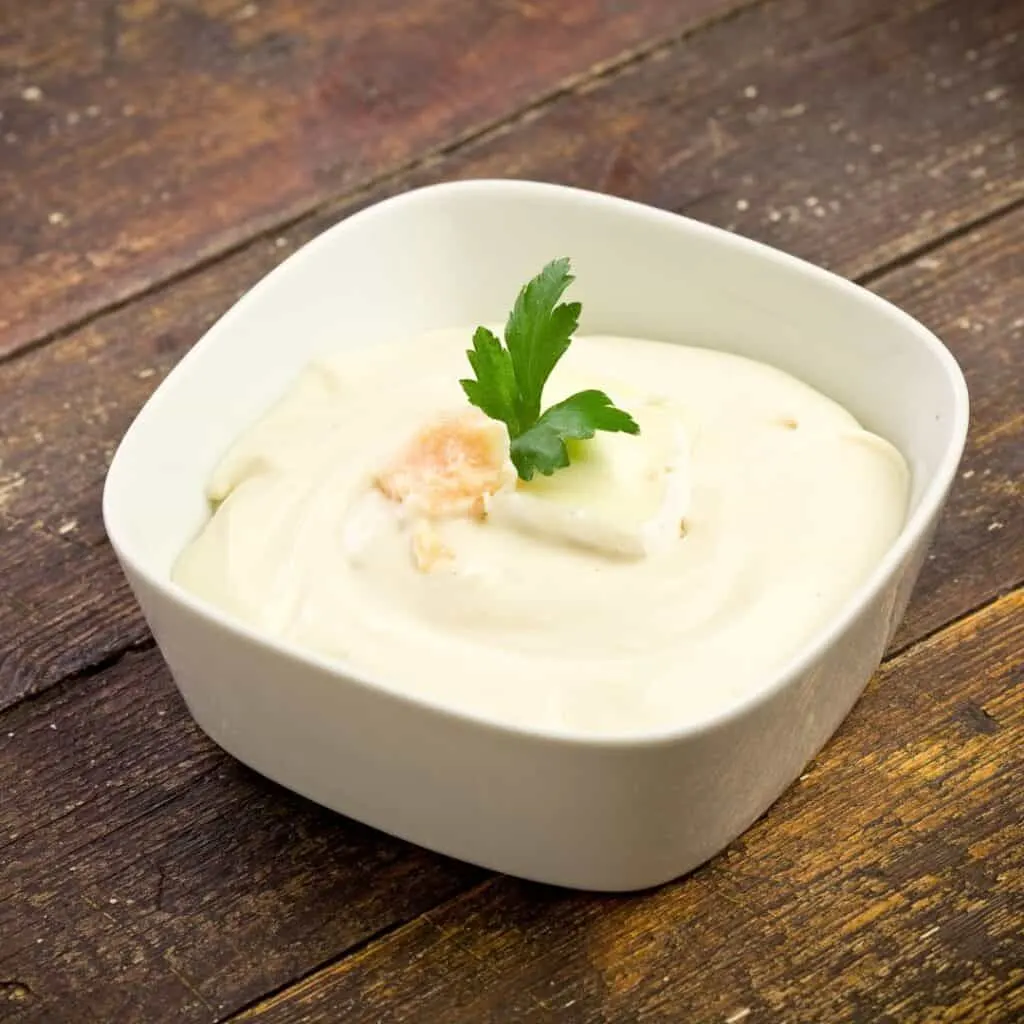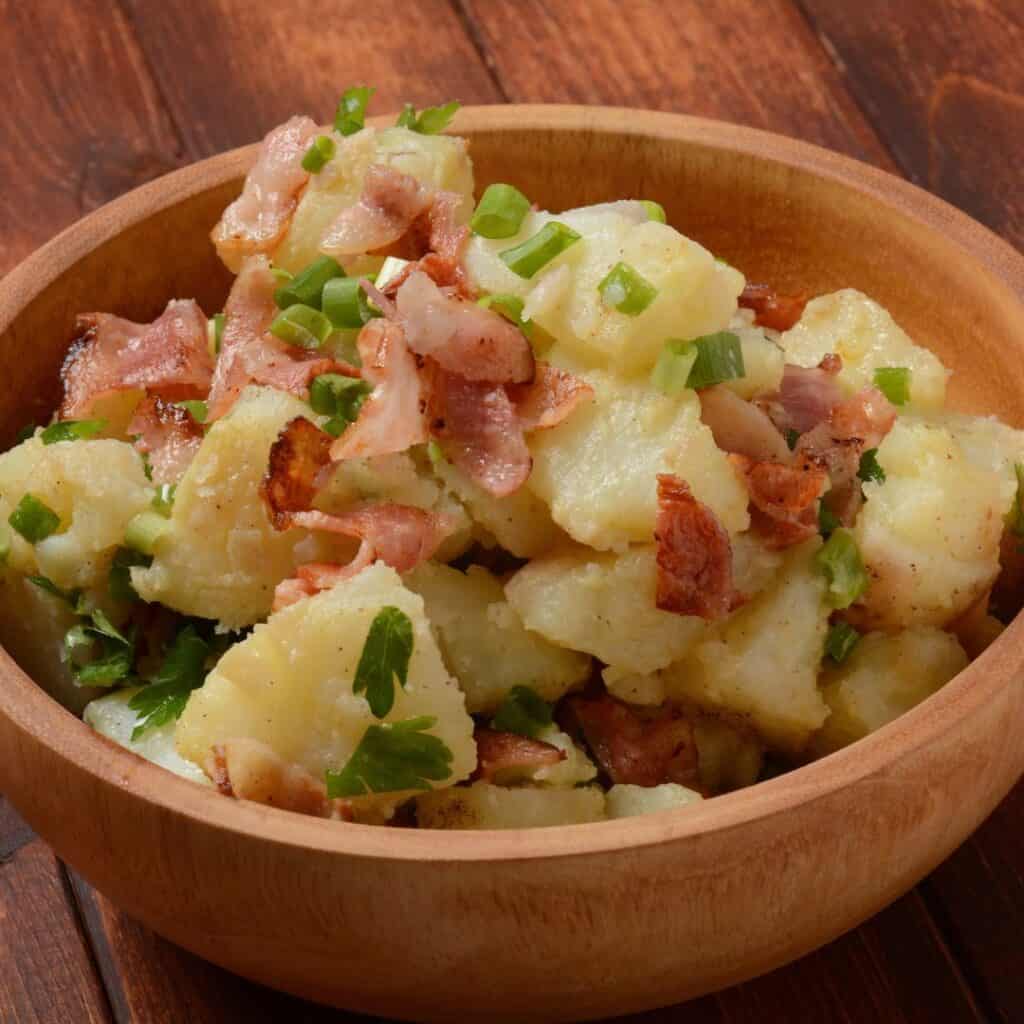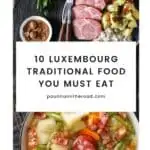With a rich culture and a love for homegrown produce, I grew up with unpretentious and delectable Luxembourg traditional food.
Even though Luxembourgish food isn’t the most known worldwide, it boasts fresh meat, fish, and vegetables (often enhanced with wine).
Whether you have a big appetite or are a picky foodie, travel Luxembourg and indulge in the Grand Duchy’s classic cravings as I share their flavorsome stories.
Luxembourg’s farming heritage and culinary influence from nearby countries brought out the best of our traditional cuisine, now gaining popularity with countless restaurants all over the country.

You, dear reader, support this blog. When you purchase through a link, I may earn a small commission. As an Amazon Affiliate, I earn from qualifying purchases.
Pssst…!!?? You can’t get enough of Luxembourg? Have a look at my other posts:
Overview: Luxembourg traditional food you’ll love!
- Judd mat Gaardebounen (Smoked pork with beans)
- Bouneschlupp (Green bean soup)
- Gromperekichelcher (Potato pancakes)
- Kachkéis (Luxembourg cheese spread)
- Rieslingspaschteit (Riesling pie)
1. Judd mat Gaardebounen (Smoked Pork with Broad Beans)

What is the most popular food in Luxembourg?
The growing prominence of Luxembourgish dishes makes it a tricky question. But one thing is sure, we love salted pork with broad beans or Judd mat Gaardebounen.
Often tagged as Luxembourg’s national dish, it came from an era when preserving food was necessary for survival, and smoking meat or Judd was found.
On the other hand, broad beans or Gaardebounen are easy to cultivate and harvest from home gardens.
The combination gave way to a hefty and hearty traditional Luxembourg food.
To prepare, the pork neck or collar is soaked in water overnight.
The next day, the meat is seasoned with vegetables and herbs such as leeks, onions, bay leaves, cloves, peppercorns, and a splash of wine before cooking them in a low-heated pot.
It helps your cravings when the pork is cut into slices and placed beside a creamy sauce of broad beans and potatoes, which I enjoy when fried and with bacon.
This proves that traditional Luxembourgish food has a strong farm-to-table orientation that continues today.
2. Bouneschlupp (Green Bean Soup)

Bouneschlupp or green bean soup may not look like the most mouthwatering food to expect, but there’s more than to what meets the eye from its simple appearance.
It’s a flavorful soup with green beans, potatoes, bacon, onions, and leeks. It tastes a little like North American chowder but is not particularly spicy.
Green beans, or Bounen in Luxembourgish, are typically harvested in late summer and early fall, so you’re likely to experience their deliciously unique taste in colder months.
Very basic, it’s one of the most cherished soups among Luxembourgish families and is featured by many local restaurants.
Some prefer it a little thicker and add flour, while others want it using bacon lardons.
I won’t say no to any variations, but I always want it served hot with potato pancakes.
3. Friture de la Moselle (River Moselle Fried Fish)

Another old-time favorite food of Luxembourg is Friture de la Moselle– a fried freshwater fish that people traditionally eat with their fingers and sourced from the Moselle River.
Typically, it consists of different species of small fish seasoned with salt and pepper, dipped into lemon juice, and battered with flour and egg. It’s always served with lemon wedges.
Friture de la Moselle is best enjoyed with sides of fries and perfectly matches with any of Luxembourg’s very owned wines. Simple and tasty, I love this delicacy for light dinners.
Being a landlocked country, Luxembourg can’t access the seas, so traditional fish dishes are based on what is caught from freshwater, such as trout, pike, and crayfish.
4. Gromperekichelcher (Potato Pancakes)

Fun fairs and festivals in Luxembourg won’t be complete without this beloved Luxembourgish crispy potato pancakes, also known as Gromperekichelcher.
Along with other traditional delicacies, it is the star of much anticipated yearly Christmas markets in Luxembourg.
If you’re new in the country, you might have trouble pronouncing Gromperekichelcher mat appel kompott!
But you won’t have trouble liking these deep-fried grated potatoes made with onion, eggs, flour, and parsley.
Traditionally served with an apple compote (sauce) pot on the side, you’ll love the sweet and salty blend of this must-try Luxembourg traditional food.
As a child, I tried having it with some Luxembourgish mustard, and since, I craved more.
The recipe’s simplicity led to more variations of this traditional snack, which is now an addition to Luxembourg breakfast foods on some menus.
5. Huesenziwwi (Rabbit in Vinegar Sauce)

A unique dish featuring rabbit cooked in a tangy vinegar sauce, Huesenziwwi is a sought-after traditional food in Luxembourg especially among the top restaurants during the game season.
This delicious classic meal is prepared by marinating pieces of hare with heavy seasoning for very long hours and cooked with wine vinegar and onions in a thick sauce made of hare or calf blood, red wine, and cognac.
While many recommend serving it with noodles and cabbage, I like it with fried bread dumplings. Either way, a glass of wine is an essential accompaniment to this traditional Luxembourg food.
Luxembourg is small in size and population, so regional differences in preparing Huesenziwwi may be minimal. However, each restaurant has its own recipe.
6. Kachkéis (Luxembourg Cheese Spread)

From Grand Duchy’s long history of cheesemaking, Kachkéis is produced without melting salts or preservatives.
You may find the smell a bit odd at first, but as they say, stinky cheese is better. It has a distinctive taste that you will appreciate, whether it is cold, hot, or cooked.
Traditionally, people cooked the Kachkéis at home, buying them uncooked and melting them with milk or cream. But these days, ready-to-eat Kachkéis are also available low-fat or with herbs.
Some cooks incorporate them with pasta, but I recommend you try the pies with garlic-Kachkéis. They are simply scrumptious!
Similar runny cheeses are also found in Franche-Comté or Lorraine, France, but Kachkéis on a Schmier (a piece of bread) spread with mustard is originally Luxembourgish.
7. Feiersténgzalot (Beef Salad)
A popular traditional appetizer that you may come across on many restaurant menus in Luxembourg is Feiersténgzalot or simply, the beef salad.
At home, it can be a refreshing and mouthwatering way of mixing leftover meat, specifically beef, with ingredients commonly found in Luxembourg’s households, such as onion, eggs, and gherkins.
On a dinner menu, I like to order this with Gebootschten Gromperen and mustard as a tasty starter.
Find this and other traditional dishes among your things to do in Mullerthal.
8. Gebootschten Gromperen (Potatoes with bacon)

With an economy that was once dependent on agriculture, you’ll notice that gromperen or potatoes are part of many dishes in Luxembourg and are typically partnered with meats such as sausages and bacon.
Speaking of bacon, you’ll love Gebootschten Gromperen mat Speck, or boiled potatoes with bacon, typically seasoned with salt, pepper, and herbs.
This simple staple is easy to prepare, and differences may only come from how the potatoes and the bacon are sliced.
Apart from boiled potatoes, another must-try delicious food in Luxembourg is Gehaanschte Gromperen, or mashed potatoes, which are made with butter and cream.
Whether as a main dish, side dish or as a snack, Gebootschten Gromperen is a versatile staple that will always captivate your palate.
9. Quetschentaart (Plum Tart)

For those who relish sweets, here’s one of the famous traditional foods in Luxembourg– Quetschentaart, better known as damson tart.
It’s commonly baked in autumn when damson plums are in season.
Damson is a type of plum with a slightly elongated shape, darker in color, and has a long thin stone. These are stoned, halved, put into a sweet pastry dough, and perfectly baked.
The tart can be sprinkled with powdered vanilla sugar which gives an aroma that people follow with their nose.
I can’t get enough of this dessert, so I match it with either a whipped cream or a scoop of ice cream. Indeed, a Luxembourg traditional food you shouldn’t miss!
You can find this delicacy in most of the pastry shops and restaurants all over Luxembourg.
10. Rieslingspaschteit (Riesling Pie)

Dubbed Grand Duchy’s queen of pies, Rieslingspaschteit (Riesling Pie) is a popular culinary tradition and a hearty meat pie.
Made of a log-shaped flaky pastry crust filled with pâté or a meat-based paste, the dish typically includes Riesling wine, which complements the richness of meat through its acidic flavor.
The hole on top of the crust is decorated like a crown and for a nice glazed finish, the pie is brushed with beaten egg yolks before baking.
This sweet treat is typically consumed cold with a variety of side dishes and of course, a glass of Riesling wine.
I tried to bake this once and realized that it can be time-consuming, which means it’s extraordinary. No wonder you’ll see them often on festive occasions and as Luxembourg Christmas food.
My Thoughts about Luxembourg’s Traditional Food

As I look back and remember how I enjoyed the traditional food of Luxembourg, it takes me back to the warmth of my home and joyful childhood.
Every special meal such as Judd mat Gaardebounen, Friture de la Moselle, and Huesenziwwi; the snacks I grew up with like Bouneschlupp (Green Bean Soup), Gromperekichelcher (Potato Pancakes) and Kachkéis-Schmier; and well-loved desserts like Quetschentaart (Plum Tart) and Rieslingspaschteit (Riesling Pie), are part of our humble past and flourishing traditional cuisine.
Many visitors look for recipes online after they experience a bite of the traditional foods of Luxembourg. Like them, explore Luxembourgish gastronomy among your things to do in Echternach or as you join day trips from Luxembourg!

Hola! I’m Paulina, a seasoned travelette who crossed the Atlantic Ocean by Boat HitchHiking. On my blog, find expert insights for an extraordinary holiday through outdoor and sustainable travel like hiking, cycling, and sailing. Let’s embark on unforgettable journeys together! 🌍🚀
















